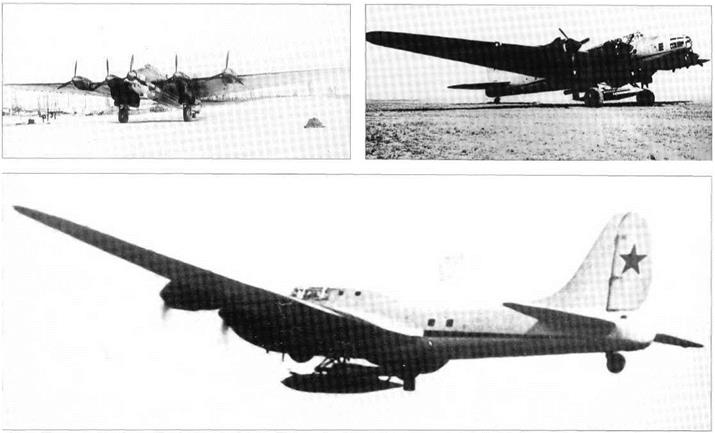Petlyakov Pe-8 experimental versions
|
Purpose: To test various items on modified Pe-8 aircraft.
Design Bureau: Originally sub-group KB-1 within special design bureau KOSOS, created in 1935 to manage the ANT-42 (ANT from Andrei N Tupolev). Prototype built at GAZ No 156, the special factory at the secure NKVD site where aircraft designers were imprisoned. Petlyakov was rehabilitated in July 1940 and made General Constructor of his own OKB until he was killed in a Pe-2 on 12th January 1942.
First flown on 27th December 1936, the ANT-42 was redesignated Pe-8 for its lead designer during 1943. Though built only in modest numbers, this heavy bomber was by that time in service in versions powered by the AM-35A, the M-30, M-40 and ACh-30B diesels and the ASh-82 radial. Because of the small numbers only a handful were available for experimental work, but the work they did was varied. One of the final batch of four, designated Pe-8ON (Osobogo Naznacheniya, special assignment) and originally built as long-range VIP transports, was used to test a range of special equipment for use in Polar regions, including navaids able to operate at 90° latitude and long-range voice communications. Using various engines, Pe-8 bombers tested a range of new designs of propeller, including types
later used for turboprops. At least three aircraft served CIAM and various engine KBs as engine test-beds, ten types of experimental engine being mounted on the wings, on the nose or under the bomb bay.
The Pe-8 was also important in the development of many types of bomb and other air- launched weapon. Such work culminated in the testing of captured German FilOS (‘V. l’) flying bombs and of the Soviet cruise missiles derived from it. Unlike the Germans, the MV S (ministry of weapons) decided that all the earliest trials should be of the air-launched versions. Launching equipment was produced at GAZ No 456 (General Constructor IV Chetverikov, see earlier), and GAZ No 51 produced three sets of pylons matched to the Pe-8. The only other possible carrier of the original single-engined missile was the Yer-2, but the Pe-8 was preferred because of its greater load-carrying ability and flight endurance. Initially 63 German missiles were launched on the Dzhisak range near Tashkent between 20th March and late August 1945. In 1946 two more Pe-8 bombers were taken from store at GAZ No 22 (the original Tupolev production plant at Kazan) and modified to carry the improved lOKh (written 10X in Cyrillic). Assisted by GAZ No 125 at Irkutsk, Factory No 51 produced 300 of this version, and 73 were tested from the Pe-8s
Top right and above: Two views of Pe-8 (ASh-82 engines) launcher for lOKh flying bombs.
between 15th December 1947 and 20th July 1948. Most had speed increased from 600 to 800km/h (497mph) by fitting the D-5 pulsejet engine, and nearly all had wooden wings. In parallel the 14Kh was produced, with the D-5 engine and tapered wings, ten being tested from Pe-8s between 1st and 29th July 1948. The final variant was the 16Kh Priboi (breakers, surf), and though this could be launched from a Tu-2 the Pe-8 remained the principal carrier. This version had twin D-14-4 engines, twin fins, precision radar/radio guidance and a speed of 858km/h, later raised to 900km/h (559mph). It was tested by the Pe-8, Tu-2 and Tu-4, but never entered service.












